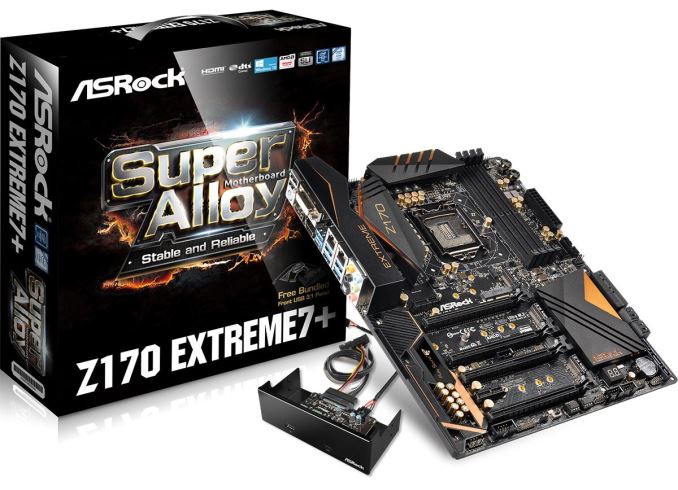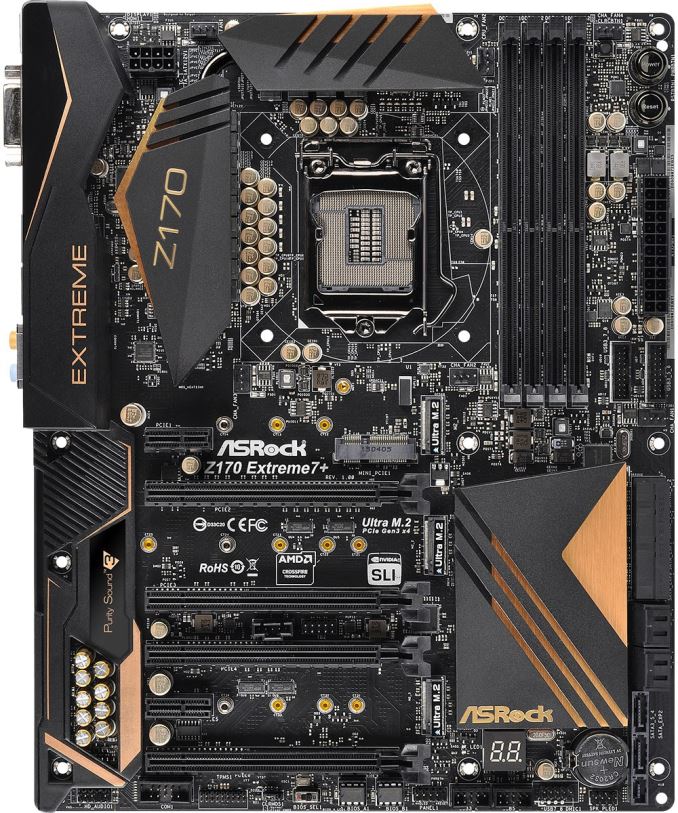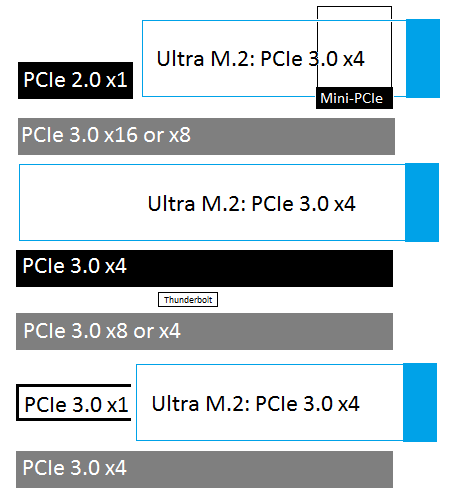The ASRock Z170 Extreme7+ Review: When You Need Triple M.2 x4 in RAID
by Ian Cutress on November 27, 2015 11:59 AM EST- Posted in
- Motherboards
- ASRock
- M.2
- Skylake
- Z170
ASRock Z170 Extreme7+ Conclusion
If you’ve skipped to the conclusion of the review first, answer this question: how important is data access storage to you? Is the main hump moving from a rotating platter drive to a solid state drive, and the rest is just icing on the cake? Or is there a burning need for multiple solid state drives in an array? One of the main selling points of the Z170 Extreme7+ is the ability to have three M.2/U.2 drives based on PCIe and put them into RAID, but how many users are realistically going to set out and buy three SSD 750s or three SM951s/950 Pro M.2 drives either as a JBOD or as a RAID-0? That answer is probably nearer 10 than 10-thousand, but would be a bit excessive to say zero.
ASRock historically does things a little bit differently to other motherboard manufacturers, from using an onboard LSI controller on consumer products to 10 gigabit Ethernet, a mini-ITX high-end desktop platform or using a silicone coating on a motherboard to repel moisture to name a few. In every motherboard manufacturer’s brainstorming room, dozens of ideas are suggested and fall to the floor, either by virtue of impractability, time, or lack of value. It’s that last one which matters the most, because if there is not value to the consumer then there is not much point in pursuing the idea. That what makes ASRock as a company interesting to watch, because their bar for ‘value’ seems to be set differently to everyone else, and this is seen partly in the Z170 Extreme7+.
Very few users will need three PCIe 3.0 x4 based M.2 slots that are RAID capable, but the Z170 chipset was designed to handle that configuration and required someone to actually go and build it. Alongside this, ASRock adds to the two USB 3.1 ports already on board with a USB 3.1 front panel that uses one of those obsolete SATA Express ports (and a USB 2.0 header) to provide a pair of front-facing USB 3.1 ports (A and C), which in itself heralds back 2011 and one of my first AnandTech reviews ever where ASRock bundled a USB 3.0 front panel in a similar fashion.
For features, the dual Intel network ports (I219-V and I211-AT) are joined by a mini-PCIe slot for users to add their own Wi-Fi module, and the onboard audio comes via an enhanced Realtek ALC1150 audio solution. Aside from the two USB 3.1 ports on the rear (A+C), we get four USB 3.0 ports on the rear and two USB 3.0 headers onboard for cases provided by an ASMedia controller. Another ASMedia controller also gives four extra SATA ports, bringing the total to ten which includes space for three SATA Express ports, although there is some switching involved and not all these feature will work at the same time with the M.2 slots also in play.
Benchmark wise, the Extreme7+ does not have MultiCore Turbo by default on the BIOS we tested, but this manifests in a much lower power consumption as a result. POST times for the board are currently the best we have seen on Z170, and the audio solution scores highest in our test so far. The only serious test that had issues was DPC Latency, though I am told that at the time of testing, due to the new platform, BIOSes are still to be optimized. A review is only ever a snapshot in time, meaning that users who purchase this motherboard and care enough about DPC Latency should update the firmware to the latest available when possible.
At $240, it sits above that popular mainstream segment of $140-$200 motherboards that will be the big sellers. The Extreme7+ sits on top of ASRock’s Extreme motherboard product list until an Extreme9/11 comes along, and the benefit of going above the regular extends to multiple Ultra M.2 ports, ten SATA ports, a wealth of USB 3.0 and a bundled USB 3.1 panel. Aside from a regular PC, if you wanted a storage platform with a strong networking base and space for RAID cards, the ASRock Z170 Extreme7+ might just have you covered this side of a high-end desktop arrangement.













63 Comments
View All Comments
DanNeely - Monday, November 30, 2015 - link
Immediate availability isn't a concern, and I'd rather have a 2x type C model anyway (Asus has announced one, but it's a 5.25" bay enclosure for a full height expansion card making it a bit of a WTF); I probably won't have a USB-C device until late summer/early fall of next year.If these can be made usable with Haswell at all is a bigger concern for me. I know I'd be bandwidth limited and only able to hit max speed on one port if the second is idle; but that's a limitation I could live with.
pedjache - Monday, November 30, 2015 - link
It's actually ASmedia controller that drives the front panel, so apart from the fact that using SATAexpress will probably disable 2 of your SATA ports, I see no other concern on usability with haswell.nunya112 - Friday, November 27, 2015 - link
how many layers in the motherboard? is there copper etc.??ASROCK interests me, as they are better priced. if they start to have better components etc. and now the only issue I have is the motherboards are usually thin, and quite flexible
extide - Monday, November 30, 2015 - link
Why do you care about the # of layers? Do you mistakenly think that more is better?tuxRoller - Saturday, November 28, 2015 - link
How many samples did you use to determine that dpc time?careyd - Saturday, November 28, 2015 - link
Ian, love the article, read every word, studied every chart. Desperate to see the headline feature of triple M2 RAID benchmarked. Preferably with Samsung 950's, since I think adapting to the Intel 750's is a lot less elegant despite the possibility of greater performance. This type of arrangement should saturate anyway. But want to see throughput and IOPS numbers. Also, if this beggar can be a chooser, I'd love to see benchmarkes of two of the M.2's striped, with a third running solo. I could envision a number of reasons why this configuration might be a preferable, having a solo M.2 for system drive and the striped pair for other data intensive tasks/media/etc. I think it would make a heck of a cache drive for Adobe After Effects.TesseractOrion - Sunday, November 29, 2015 - link
I think I'd choose striped for OS, solo for redundancy instead, I'd want the OS to be as responsive as humanly (computerly) possible.jasonelmore - Sunday, November 29, 2015 - link
what a waste. the OS is never going to need 2.1GB Per second write and reads. Only a scratch disk or video editing app would use it, then you might as well use careyd configurationmurak01 - Sunday, November 29, 2015 - link
A few tests with three 950 Pro in RAID0 would be interesting. Thanks for a good review!Reflex - Sunday, November 29, 2015 - link
Right now you can pick up 250GB Samsung 850 EVO M.2 SSD's for only $79 at Newegg and Amazon. Given that this board is $220, dropping $240 on storage is not ridiculous and should perform exceptionally well.